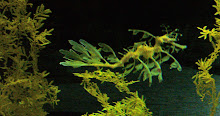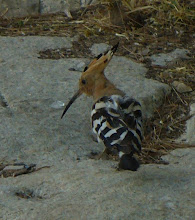Continuing with the theme of insects covered in dew, image of the day today is this stunning photo by Jens Kolk of a ladybird (aka "ladybug") covered in dew-
http://www.stumbleupon.com/su/2omVNp/www.naturfotografen-forum.de/o30241-hier%2Bdas%2Bzweite%2BND
thanks to Stumbleupon.com
Tuesday, 30 March 2010
Saturday, 27 March 2010
Link of the day- insects covered in dew droplets...
...make much more interesting photographic subjects than you might expect-
this article gives more details and has a gallery of 3 stunning dew-drenched insects
http://www.thesun.co.uk/sol/homepage/news/2909586/Amazing-snaps-of-dew-droplets-on-bugs.html
this article gives more details and has a gallery of 3 stunning dew-drenched insects
http://www.thesun.co.uk/sol/homepage/news/2909586/Amazing-snaps-of-dew-droplets-on-bugs.html
Labels:
dew,
dewdrops,
insect photographs,
Insects,
Link of the day
Friday, 26 March 2010
Link of the day- Weird and Ugly endangered species
Ever seen a ghost bat? or a saiga antelope? The "ARKive" project organised by the British charity Wildscreen has been documenting some of the world's more obscure endangered species. You can see some of their images here-
http://www.thesun.co.uk/sol/homepage/news/Green/2907659/Like-a-bat-out-of-hell-the-worlds-ugliest-endangered-species.html
http://www.thesun.co.uk/sol/homepage/news/Green/2907659/Like-a-bat-out-of-hell-the-worlds-ugliest-endangered-species.html
Labels:
ARKive,
ghost bat,
Link of the day,
purple frog,
Saiga antelope,
Wildscreen
Tuesday, 23 March 2010
Quote of the week- D. H Lawrence- the joy of life

“For man, as for flower and beast and bird, the supreme triumph is to be most vividly, most perfectly alive.”- D. H. Lawrence
quote source: www.thinkexist.com
Image- American Bison (Bison bison)by Jack Dykinga. This is a public domain image- for details see- http://en.wikipedia.org/wiki/File:American_bison_k5680-1.jpg
Monday, 22 March 2010
Link of the day- seaweed and obesity
Hi. Welcome (back) to Weirdbeautiful. Link of the day today is this article-
http://uk.news.yahoo.com/21/20100322/tuk-seaweed-bread-key-to-obesity-6323e80.html on the discovery that a chemical in sea kelp (alginate) can be added to food to reduce fat uptake and therefore help prevent obesity. The scientific relevance of the article is obvious, but the weirdness is the part where they talk about running tests on "an artificial gut" .... the mind boggles...
http://uk.news.yahoo.com/21/20100322/tuk-seaweed-bread-key-to-obesity-6323e80.html on the discovery that a chemical in sea kelp (alginate) can be added to food to reduce fat uptake and therefore help prevent obesity. The scientific relevance of the article is obvious, but the weirdness is the part where they talk about running tests on "an artificial gut" .... the mind boggles...
Friday, 12 March 2010
Image of the day- Spring crocuses

Image by Victoria Neblik. purple crocuses in North Yorkshire, UK. Copyright V Neblik, 2010, All rights reserved.
Thursday, 11 March 2010
Link of the day- the weird and wonderful world of animal tongues
The latest issue of Discover magazine to be posted online has these wonderful and most definitely weird photos of animals tongues/mouth parts and animals drinking.
http://discovermagazine.com/photos/02-how-animals-suck-9-creatures-with-inventive-slurping-techniques
All you could ever want to know about the mouth parts of bats and barnacles, bristleworms and giraffes...
http://discovermagazine.com/photos/02-how-animals-suck-9-creatures-with-inventive-slurping-techniques
All you could ever want to know about the mouth parts of bats and barnacles, bristleworms and giraffes...
Labels:
Discover magazine,
Link of the day,
mouth parts,
tongues
Wednesday, 10 March 2010
Quote of the week- Albert Camus- Invincible summer

"In the midst of winter, I finally learned there was in me an invincible summer" - Albert Camus
Image- wild deer, North Yorkshire, UK, (c) V. Neblik, 2009
Monday, 8 March 2010
Cheering-up butterfly- Swallowtail

Hi. Welcome to Weirdbeautiful. I am breaking the "cheering-up bird" formula today with this "cheering-up butterfly"- a Western Tiger Swallowtail (Papilio rutilus) to be precise. This image is by Mila Zinkova and was taken from this address- http://en.wikipedia.org/wiki/File:Swallowtail_butterfly_2.JPG. It is reproduced here under the terms and conditions of its Creative Commons 3.0 licence- for more details of the licence, click [here].
You can find more of Mila Zinkova's pictures [here]
Saturday, 6 March 2010
Image of the day- Bird of Paradise flower

Today's picture is a "Bird-of-paradise flower", Strelitzia reginae
, which is a South African plant also called a "crane flower" or just "Strelitzia"
Image by "Plane 777" - source and copyright details -> http://en.wikipedia.org/wiki/File:IMG_8679.jpg
Wednesday, 3 March 2010
The Art of Science- Stephen Wilson, Art and Science Now- Link of the Day
...is clearly a theme close to my heart. Today's link is to a review of a book: "Art + Science Now" on just this theme. Of course, now that I am in the final stages of writing my own book in this genre- "Weirdbeautiful", I am conflicted about posting links to works in this field by other people. Minor rivalries aside, if the picture in this article is anything to go by, "Art + Science Now" is, indeed, "eye catching stuff", just as the as the review says-
http://www.guardian.co.uk/artanddesign/2010/feb/28/environmental-art
Thanks to Joe Wakeling for the tip-off.
You can find more details about the book "Weirdbeautiful" [here] - you may have to scroll down. Things have moved on since I wrote that post and I will post more details nearer to the book's release. You can also join the weirdbeautiful mailing list for advance notification by e mailing neblik@yahoo.co.uk with the words "weirdbeautiful book mailing list" in the headline. Your e mail address will not be used or abused for any other purpose and will not be passed on to any third party.
http://www.guardian.co.uk/artanddesign/2010/feb/28/environmental-art
Thanks to Joe Wakeling for the tip-off.
You can find more details about the book "Weirdbeautiful" [here] - you may have to scroll down. Things have moved on since I wrote that post and I will post more details nearer to the book's release. You can also join the weirdbeautiful mailing list for advance notification by e mailing neblik@yahoo.co.uk with the words "weirdbeautiful book mailing list" in the headline. Your e mail address will not be used or abused for any other purpose and will not be passed on to any third party.
Tuesday, 2 March 2010
Science Update- Promiscuous females and why they are useful
Hi. Welcome to Weirdbeautiful- the blog devoted to the strange appeal of the natural world.
Today's oddity is this story about why promiscuity in females prevents a population going extinct-
http://uk.news.yahoo.com/21/20100225/thl-promiscuous-females-help-species-d831572.html
When I was studying (micro)biology at UCL, we had what seemed to be endless genetics lectures in the second and third years on population genetics- the kind of things that Richard Dawkins and a thousand other, less well known, scientists get really excited about. There is the idea that parts of an organism's genetic code can be "at war" as it were with other parts- reproducing wildly and spreading, a bit like a computer virus, at the expense of other parts of the genome, the animal and the population of animals in general. We had to use obscure formulae to calculate what would happen under different circumstances. It was all very dry, but also very interesting. I personally think that, whatever faults Ricahrd Dawkins may or may not have, one of his great strengths is that he writes on this interesting subject (theoretical biology and genetics) in an approachable and catchy way: something that is much more difficult than it sounds.
Of course, Richard Dawkins is not the only person in this field- the article above is another great example. Essentially, it relates some new research by Prof Nina Wedell and her colleagues on just such a parasitic or selfish part of the genome: a "sex-ratio distortion (SR) chromosome" and how promiscuous females produce off spring that are free from it.
Today's oddity is this story about why promiscuity in females prevents a population going extinct-
http://uk.news.yahoo.com/21/20100225/thl-promiscuous-females-help-species-d831572.html
When I was studying (micro)biology at UCL, we had what seemed to be endless genetics lectures in the second and third years on population genetics- the kind of things that Richard Dawkins and a thousand other, less well known, scientists get really excited about. There is the idea that parts of an organism's genetic code can be "at war" as it were with other parts- reproducing wildly and spreading, a bit like a computer virus, at the expense of other parts of the genome, the animal and the population of animals in general. We had to use obscure formulae to calculate what would happen under different circumstances. It was all very dry, but also very interesting. I personally think that, whatever faults Ricahrd Dawkins may or may not have, one of his great strengths is that he writes on this interesting subject (theoretical biology and genetics) in an approachable and catchy way: something that is much more difficult than it sounds.
Of course, Richard Dawkins is not the only person in this field- the article above is another great example. Essentially, it relates some new research by Prof Nina Wedell and her colleagues on just such a parasitic or selfish part of the genome: a "sex-ratio distortion (SR) chromosome" and how promiscuous females produce off spring that are free from it.
Monday, 1 March 2010
Cheering-up bird 24-Toucan

Today's cheering up bird is the keel-billed toucan, Ramphastos sulfuratus this image is by Raúl Hernández González and was uploaded and reproduced here from http://en.wikipedia.org/wiki/File:Ramphastos_sulfuratus_-Spain_-Zoo_-upper_body-8a.jpg under the conditions of its creative commons 2.0 licence: for details, see http://en.wikipedia.org/wiki/File:Ramphastos_sulfuratus_-Spain_-Zoo_-upper_body-8a.jpg
Subscribe to:
Comments (Atom)








